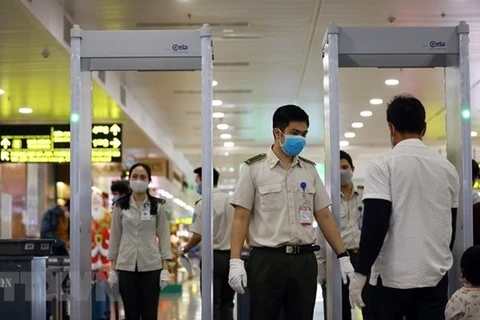Quang Ninh (VNA) - The northern province of Quang Ninh has adopted a range of measures to ensure safety during industrial production amid the unpredictable developments of the COVID-19 pandemic and the more contagious variants of the coronavirus.
There are still localities, however, exhibiting shortcomings in controlling and preventing the virus from entering the province. In particular, some workers at industrial parks returning from disease-hit areas did not truthfully complete health declarations or undergo quarantine.
Secretary of the provincial Party Committee and head of the province’s Steering Committee for COVID-19 Prevention and Control Nguyen Xuan Ky said reviewing all measures and policies implemented is an urgent matter to identify shortcomings and weaknesses and determine goals and strategies for the new period.
He stressed the need to maintain production and business and ensure absolute safety in industry, especially the coal sector.
The provincial leader asked the heads of management boards at industrial parks and clusters and heads of production and business establishments to take responsibility in managing health issues and providing safe conditions for workers, especially in localities such as Mong Cai, Ha Long, Quang Yen, Uong Bi, and Dong Trieu.
Industrial parks and clusters must hold comprehensive and periodical testing for workers, Ky said.
Quang Ninh has persistently implemented its pandemic prevention and control strategy based on the principles of preventing, detecting, tracing, quarantining, zoning off, stamping out the pandemic, and quickly stabilising the situation.
Ky requested that localities continue to strictly control and prevent all pathogens from entering the province and at the same time consolidate forces and promote the role of COVID-19 control checkpoints, actively carry out screening and testing to quickly detect any risks to the community, and focus on monitoring high-risk sites such as medical clinics, factories, enterprises, industrial parks, markets, supermarkets, and houses of worship.
It is also necessary to continue tightening the management of the population regarding residency, temporary residency, temporary absences, and changes in status, especially among workers at industrial parks, industrial clusters, and production and business establishments, while promoting the role of self-monitoring teams in the community and strictly following the Health Ministry’s “5K message”: Khau trang (facemasks) - Khu khuan (disinfectant) - Khoang cach (distancing) - Khong tu tap (no gatherings) - Khai bao y te (health declarations).
Quang Ninh province has not detected any cases of community transmission of COVID-19 since May 7. Preventive measures continue to be carried out at the highest level.
The province has assigned localities to complete quarantine plans, strictly control people entering through checkpoints from pandemic-hit areas, direct workers not to leave the province, periodically hold screening and testing at factories, and step up voluntary testing among local people.
It has also strengthened control over its land and sea borders.
Hit hard by a resurgence of COVID-19 in the first quarter, Quang Ninh nonetheless posted gross regional domestic product (GRDP) growth of 9.02 percent, or double the national average.
This put the province in second place in terms of GRDP growth in the northern key economic region, following the neighbouring city of Hai Phong.
The main growth driver in the opening quarter was the processing and manufacturing sector, which increased 35.6 percent year-on-year compared to 20.8 percent in the same period last year.
This contributed to record industrial growth of 8.73 percent in January-March.
The province aims to maintain its GRDP growth rate at more than 10 percent this year.
It has set a goal of having modern industry and service sectors and becoming one of the region’s most comprehensive and dynamic development hubs by 2025, which is part of its growth targets for 2020-2025./.
There are still localities, however, exhibiting shortcomings in controlling and preventing the virus from entering the province. In particular, some workers at industrial parks returning from disease-hit areas did not truthfully complete health declarations or undergo quarantine.
Secretary of the provincial Party Committee and head of the province’s Steering Committee for COVID-19 Prevention and Control Nguyen Xuan Ky said reviewing all measures and policies implemented is an urgent matter to identify shortcomings and weaknesses and determine goals and strategies for the new period.
He stressed the need to maintain production and business and ensure absolute safety in industry, especially the coal sector.
The provincial leader asked the heads of management boards at industrial parks and clusters and heads of production and business establishments to take responsibility in managing health issues and providing safe conditions for workers, especially in localities such as Mong Cai, Ha Long, Quang Yen, Uong Bi, and Dong Trieu.
Industrial parks and clusters must hold comprehensive and periodical testing for workers, Ky said.
Quang Ninh has persistently implemented its pandemic prevention and control strategy based on the principles of preventing, detecting, tracing, quarantining, zoning off, stamping out the pandemic, and quickly stabilising the situation.
Ky requested that localities continue to strictly control and prevent all pathogens from entering the province and at the same time consolidate forces and promote the role of COVID-19 control checkpoints, actively carry out screening and testing to quickly detect any risks to the community, and focus on monitoring high-risk sites such as medical clinics, factories, enterprises, industrial parks, markets, supermarkets, and houses of worship.
It is also necessary to continue tightening the management of the population regarding residency, temporary residency, temporary absences, and changes in status, especially among workers at industrial parks, industrial clusters, and production and business establishments, while promoting the role of self-monitoring teams in the community and strictly following the Health Ministry’s “5K message”: Khau trang (facemasks) - Khu khuan (disinfectant) - Khoang cach (distancing) - Khong tu tap (no gatherings) - Khai bao y te (health declarations).
Quang Ninh province has not detected any cases of community transmission of COVID-19 since May 7. Preventive measures continue to be carried out at the highest level.
The province has assigned localities to complete quarantine plans, strictly control people entering through checkpoints from pandemic-hit areas, direct workers not to leave the province, periodically hold screening and testing at factories, and step up voluntary testing among local people.
It has also strengthened control over its land and sea borders.
Hit hard by a resurgence of COVID-19 in the first quarter, Quang Ninh nonetheless posted gross regional domestic product (GRDP) growth of 9.02 percent, or double the national average.
This put the province in second place in terms of GRDP growth in the northern key economic region, following the neighbouring city of Hai Phong.
The main growth driver in the opening quarter was the processing and manufacturing sector, which increased 35.6 percent year-on-year compared to 20.8 percent in the same period last year.
This contributed to record industrial growth of 8.73 percent in January-March.
The province aims to maintain its GRDP growth rate at more than 10 percent this year.
It has set a goal of having modern industry and service sectors and becoming one of the region’s most comprehensive and dynamic development hubs by 2025, which is part of its growth targets for 2020-2025./.
VNA























